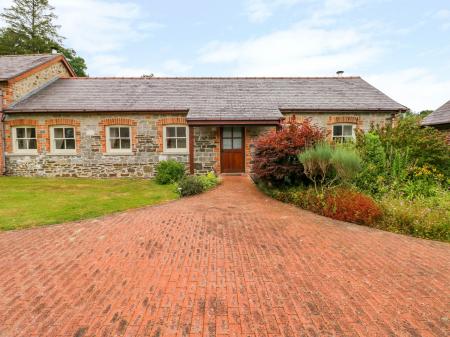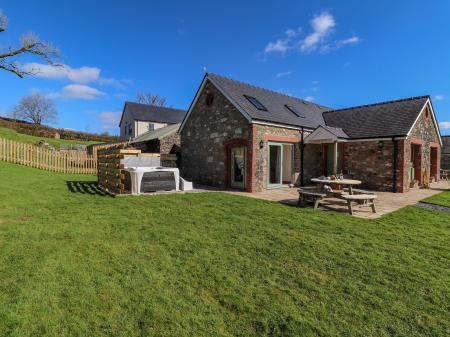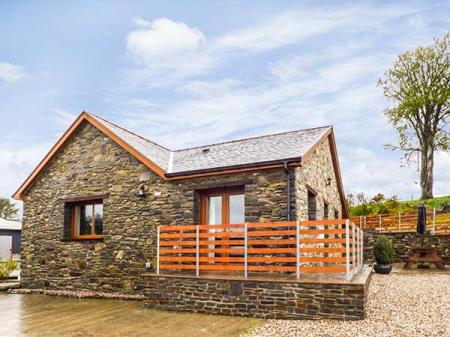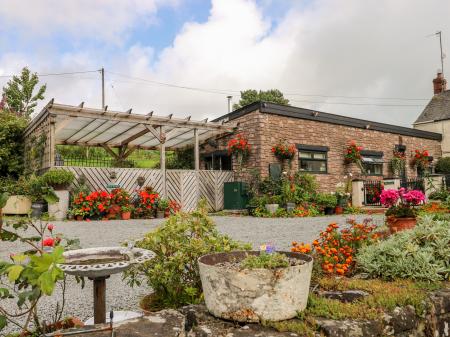
History
The gardens are a blend of old and new. The old dates back to the early 17th century, when the powerful Middleton family erected a mansion here on land that had been farmed for over 2,000 years. In the 7th century AD, this area formed part of the Welsh kingdom of Seisyllwg, possibly created from the pre-Roman kingdom of the Demetae tribe. After the Norman invasion of Wales, the former kingdom was reduced to an outpost of the Princes of Deheubarth.
The Princes, in turn, were forced out by the English crown, but by the early 17th century the estate was leased by Christopher Middleton, vicar of Llanarthne Church, from the Duchy of Lancaster.
It seems remarkable that a vicar could amass the income needed to lease a large estate, but Middleton was no ordinary vicar; he owed his wealth to the East India Company. Three of his brothers were among the original investors in the Company, which was granted an incredibly lucrative monopoly on trade with India.
In 1789 Sir William Paxton bought the estate and set about creating a water garden around a new mansion house. Like the Middletons, Paxton had made his fortune in the East India Company, rising from a simple sailor to become Master of the Mint in Bengal.
Paxton made an enormous amount of money trading illegally with the Dutch, but he managed to extricate himself and his money from the Company before he faced public disgrace.
Paxton called upon the architect Samuel Pepys Cockerell to design an opulent new mansion and turned the earlier 17th-century house into a farm building. On a hill overlooking the mansion, Paxton erected a dining pavilion now known as Paxton's Tower.
Paxton's water garden was an amazing project combining innovative engineering and aesthetic design. A system of reservoirs, sluices, and dams fed streams linked to ponds and lakes by a series of cascades.

After his death the estate was sold to a wealthy a West India merchant and banker named Edward Hamlin Adams. Adams came from a long-established Barbados family and made his money in less than savoury business ventures. according to his own descendants, he spent much of his time engaged in disputes with the local parson, which isn't surprising for he refused utterly to pay tithes.
Adams was followed by his son Edward, who changed the family name to Abadam. The younger Edward seems to have been just as disagreeable as his father and squandered the family fortune in a vain attempt to have his brother's children declared illegitimate.
Under his ownership the once-flourishing water gardens were allowed to fall into decay, and generations of subsequent owners let the estate fall into a state of disrepair.
The house was eventually pulled down after a fire, and the historic gardens might have vanished completely were it not for a chance discovery. The aunt of artist William Wilkins was walking her dog in the woods at Pont Felin Gat when she discovered the ruins of water features. She told her nephew of her discovery, and the rest, as the saying goes, is history.
Wilkins lobbied for a national botanic garden incorporating the historic garden features. After years of planning and work, the gardens were opened in 2000, with the Great Glasshouse standing on the site of Cockerell's mansion house.
The centrepiece of the botanic gardens is this amazing structure designed by Norman Foster and Partners. The Great Glasshouse is the largest single span glasshouse in the world, stretching 328 feet long. Within the glasshouse is a steep-sided ravine dropping almost 20 feet into the earth. The ravine sides are cut to form rock terraces, and streams and waterfalls tumble down to a lake at the bottom of the ravine.
The humid environment created by the ravine makes for a unique habitat for tropical plants and species rarely seen in Britain. Experience a recreation of a Spanish olive grove, see fuchsias from Chile, and find out what its like after a bushfire in Australia.
There's far more to see than just the Great Glasshouse, though. The grounds cover 568 acres, dotted with historic buildings and futuristic prototypes. See a Japanese Garden, containing a teahouse, surrounded by cherry trees. Follow lakeside walks and experience the restored double-walled garden. Sculptures are scattered throughout the gardens.

Highlights
Garden Lakes
The garden is based around a network of lakes, which act as a border between formal and informal garden areas. The lakes were laid out by Sir William Paxton, who used sluices, dams, and bridges to create lakes both as a picturesque garden feature but also to provide a clean water supply for Middleton House. Wet ground on the banks of the lakes provide habitat for water-loving perennials like gunnera, irises, primulas, and flowering skunk cabbage.
Millennium Stone
On the water's edge are a pair of fascinating elongated stones, one lying flat and the other standing upright. The story of the stones goes back to 2000 when archaeologists attempted to recreate the journey of stones quarried in the Preseli Hills to Stonehenge in Wiltshire. The experimenters wanted to discover how the massive stones were carried such a long distance.
A team of volunteers pulled the 4 tonne stone on a wooden sledge across the Pembrokeshire landscape and put it on a wooden raft at Milford Haven. Unfortunately, the experiment came to a sudden end when the raft sank in the sea. The stone was put on display the lake shore. Near it is an upright 'bluestone' quarried in the Preseli Hills. The bluestones were reputed to have healing properties and were extensively used at Stonehenge.

Great Glasshouse
The showpiece of the National Botanic Garden is the remarkable Great Glasshouse, the largest single-span glasshouse in the world and home to the largest collection of Mediterranean plants in the Northern Hemisphere. Within the Great Glasshouse are some of the rarest, most-endangered plants in the world, covering six areas; South Africa, California, Australia, Chile, the Canary Islands, and the Mediterranean Basin.
The interior is a maze of trails taking visitors through 3,500 sq. metres of terraces, scree slopes, and sandstone cliffs, with contrasting areas of light and shade, dry and humid habitats where these rare plants can flourish. One of the most interesting things you notice in the Great Glasshouse is that though the plants come from such diverse regions of the globe they share many similarities, showing how they have had to adapt to their environments.

Ghost Forest
Just above the lakes is a modern art installation known as Ghost Forest, created by artist Angela Palmer and formed of bizarre tree roots from Ghana. The Ghost Forest acts as a reminder of the loss of rainforest to logging and its effects on global climate change.

Principality House & Wallace Garden
Next to the Great Glasshouse is Principality House, the only part of Sir William Paxton's mansion to survive. Though it looks like a mansion in miniature it was actually used as a combination servant's quarters, brewhouse, kitchen, and laundry. After the 1931 fire that destroyed the mansion itself this building became a farmhouse. It is now used as a conference centre.
Outside the house is the Wallace Garden, intended to promote an interest in plant breeding and genetics. The garden paths are arranged in the shape of a DNA double-helix. Themed garden beds illustrate how humans have cultivated varieties of wild plants such as dahlias and sunflowers. The garden is named for naturalist Alfred Wallace, whose work on the natural selection of species prompted Charles Darwin to publish his own research.

Boulder Garden
On an exposed slope overlooking the water is the Boulder Garden, a terraced garden with a distinct Mediterranean theme. The garden features warm-climate plants that would ordinarily find it hard to thrive in the damp climate, but here they flourish due to the stony soil. Shrubs like juniper and cistus grow here, as do hellebores and shade-loving euphorbias.

Apothecary Hall & Garden
One of the most interesting garden features has little to do with horticulture; its a recreation of a traditional apothecary's shop. Occupying a stone barn beside Millennium Square is Apothecary's Hall where you will find an old-fashioned shop 'selling' potions, tinctures, powders, and syrups used to create pills and ointments that promised to treat a wide variety of ailments.
See proprietary medicines and weigh up their bold promises against modern treatments. Listen to short stories of life as an Edwardian apothecary and see how plants have traditionally been used for medical treatments in various countries around the world.
Outside the Hall is the Apothecary's Garden, a themed garden focussed on plants commonly used for medicinal purposes. The garden is planted according to species used to treat different body systems, such as Skin, Digestion, Circulation, and Cancer. Near the Hall is a garden area given over to exploring the history and culture of using medicinal plants to treat diseases. The apothecary's Garden aims to become one of the most beautiful and inspiring physic gardens in Britain.

Double Walled Garden
This fascinating 3-acre garden shows how flowering plants evolved and is based in the original kitchen garden for Middleton House. The garden takes its name from its use of two walls to create microclimate growing zones. The garden has a stone outer wall and uses brick for interior walls. This style is often found in Scotland where it was thought to extend the growing season, but is not common in Wales or England.
The garden is divided into four quadrants. The first three show how flowering plants evolved over millennia, from ancient water lilies to modern cultivars. As you travel the paths you move through 150 million years of evolution. Quad 1 looks at 'monocots', plants with a single seed leaf. Quads 2 and 3 look at 'Eudicots', plants with two seed leafs and flowering parts in twos, fours, and fives. Quad 4 brings the evolutionary tale up to date with a modern kitchen garden.

Butterfly House
On the west side of the Double Walled Garden is the Butterfly House, a humid glasshouse where rare tropical butterflies thrive. This is one of the most popular garden features and it is no wonder, for you can get very close to unusual and vividly colourful butterflies such as the huge Amazonian Blue Morpho and the Greta Oto glasswing with its transparent wings. See butterflies coloured to resemble poisonous insects as a way of warding off predators. You can also observe a butterfly feeding area.

Japanese Garden
Just outside the Double Walled Garden is a recreation of a Japanese Garden named Sui Ou Tei, reflecting the national flowers of Japan and Wales; the cherry tree and the daffodil. The Japanese Garden was exhibited at the 2001 Chelsea Flower Show where it won the 'Best in Show' award. It was disassembled and carried to the National Botanic Garden piece by piece and reassembled. It is built around three traditional elements of a Japanese garden; a tea garden, stream and lake garden, and a gravel garden.
The materials were carefully selected to create a scaled-down version of Japanese scenery. Every garden material is symbolic and together create a sense of peace and harmony. That peace theme is emphasised even further, for just a few steps from the Japanese Garden is a striking Peace Statue, depicting a runner in the world's longest relay run, the Peace Run, in which runners carry a flaming peace torch and pass it on as a symbol of universal hope.

Bee Garden
Just outside the Double Walled Garden is the Bee Garden, home to 250,000 honey bees. You can safely get close to the beehives by entering a protected viewing building with large viewing windows. Inside the viewing building is an exhibition on the life of a bee and how beekeepers look after the hives.

Aqualab
On the far side of The Broadwalk is a learning centre perched on stilts over the marshy water. Aqualab is an educational laboratory aimed at giving students young and old the chance to explore the natural world. Aqualab holds day and evening courses, activities, and family-oriented programmes. The buildings are warmed by a water heat source pump that uses the ambient heat of sub-surface water directly below the buildings.
These are just some of the highlights; the Botanic Gardens is a place you could spend hours, or even days, exploring and still find something wonderful and new. There are woodland walks, education area, a science centre, dipping ponds, a performance stage, a fascinating historical ice house, shops, a cafe and restaurant, children's' play area, countryside walks, a conservation exhibit, and much, much more. You will want to return again and again to get the most out of this fascinating site.












